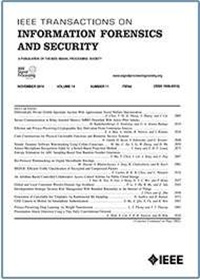Multi-User Key Rate Optimization for Near-Field Extremely Large-Scale Antenna Array Communications
IF 8
1区 计算机科学
Q1 COMPUTER SCIENCE, THEORY & METHODS
IEEE Transactions on Information Forensics and Security
Pub Date : 2025-07-30
DOI:10.1109/TIFS.2025.3594198
引用次数: 0
Abstract
Extremely large-scale antenna arrays (ELAA) require near-field spherical wave modeling due to the substantial increase in the number of antennas, which introduces new spatial dimensions to physical layer key generation (PLKG). We investigate multi-user PLKG in near-field environments, where a base station with an ELAA simultaneously generates secret keys with multiple users. We derive an analytical expression for the key rate (KR). By utilizing spatial dimensions of distance and angle in near-field environments, we apply eigenvalue decomposition and singular value decomposition to design precoding matrices to reduce interference among user equipments (UEs) and extract uncorrelated subchannels. Given that the KR is non-convex, we approximate it and optimize the precoding matrix to increase the KR. After precoding design, the KR depends on the transmit power allocated to the subchannels. Two optimization problems are formulated to further optimize transmit power allocation. The first problem focuses on maximizing the sum KR. We apply the Lagrange multiplier method to determine the optimal power allocation variables by searching the Lagrange multiplier. To reduce computational complexity, a supervised feedforward neural network (FNN) is designed to capture the relationship between the power allocation variables and the Lagrange multiplier. The second optimization problem focuses on KR fairness. By introducing a slack variable that is smaller than the KRs of all users, we use the CVX toolbox to find optimal power allocation variables that maximize this slack variable. To further reduce complexity, the Lagrange multiplier method offers an analytical solution for power allocation variables in terms of Lagrange multipliers determined by the slack variable in the high-power case. We employ a bisection algorithm to find the slack variable. Furthermore, we propose an FNN to map transmit power to the slack variable. Simulations demonstrate that the proposed methods efficiently leverage near-field effects for multi-user PLKG, reducing pilot overhead.近场超大规模天线阵列通信的多用户密钥速率优化
由于天线数量的大幅增加,超大规模天线阵列(ELAA)需要近场球面波建模,这为物理层密钥生成(PLKG)引入了新的空间维度。我们研究了近场环境下的多用户PLKG,其中具有ELAA的基站同时与多个用户生成密钥。我们推导了关键利率(KR)的解析表达式。利用近场环境中距离和角度的空间维度,采用特征值分解和奇异值分解设计预编码矩阵,减少用户设备间的干扰,提取不相关子信道。考虑到信道的非凸性,我们对其进行近似,并对预编码矩阵进行优化以提高信道的预编码系数,预编码后信道的预编码系数取决于分配给子信道的发射功率。为进一步优化发射功率分配,提出了两个优化问题。第一个问题的重点是KR和的最大化,我们应用拉格朗日乘数法通过搜索拉格朗日乘数来确定最优的功率分配变量。为了降低计算复杂度,设计了一种监督前馈神经网络(FNN)来捕捉功率分配变量与拉格朗日乘子之间的关系。第二个优化问题是KR公平性问题。通过引入一个小于所有用户的KRs的闲置变量,我们使用CVX工具箱来找到最大化该闲置变量的最佳功率分配变量。为了进一步降低复杂度,拉格朗日乘数法给出了大功率情况下由松弛变量决定的拉格朗日乘数对功率分配变量的解析解。我们采用了一种二分法来求松弛变量。此外,我们还提出了一种模糊神经网络将发射功率映射到松弛变量。仿真结果表明,该方法有效地利用了多用户PLKG的近场效应,降低了导频开销。
本文章由计算机程序翻译,如有差异,请以英文原文为准。
求助全文
约1分钟内获得全文
求助全文
来源期刊

IEEE Transactions on Information Forensics and Security
工程技术-工程:电子与电气
CiteScore
14.40
自引率
7.40%
发文量
234
审稿时长
6.5 months
期刊介绍:
The IEEE Transactions on Information Forensics and Security covers the sciences, technologies, and applications relating to information forensics, information security, biometrics, surveillance and systems applications that incorporate these features
 求助内容:
求助内容: 应助结果提醒方式:
应助结果提醒方式:


